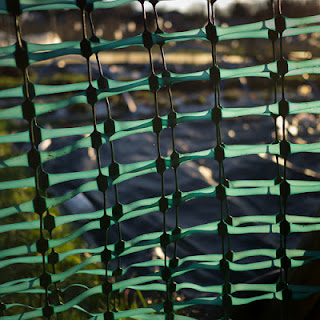Regular readers of this blog will know that I’m a big fan of the joiner pictures of Noel Myles. I really recommend seeing his work when exhibited, because his images are generally quite large, and work well when seen large. Web pages and computer projects just don’t show the size and clarity of his work. Noel currently has a piece called Earth that is on show at the Sainsbury Centre for Visual Arts. Made up from 288 individual 12” x 8” prints, it is, as you can see, huge, measuring 2.75 x 6.53 m. He reports having very sore thumbs after pushing in over a thousand pins to mount the PVC reinforced prints. The installation will be on view until Easter at least, but due to alterations at the SCVA, it is worth checking in advance.
 |
| Earth © Noel Myles |
If Noel’s Still Films images can be considered as a form of photographic cubism, then this work is a close parallel to the colour field (!) work of Mark Rothko. The hue of the ploughed fields is as found; the typically rich red soil from the around Hereford and the light hues from East Anglia. To quote Noel: ‘I took the photos one winter in Suffolk, Essex and Herefordshire. I knew I wanted the red soil that's there. The bluish tinge is frost. I was using the different colours in a similar way to an artist using paint; the overall colour of the piece emerging with the placement of one colour next to another. After this series I moved from film to digital. Changing rolls with numb fingers and dropping them was too much for me.’
As with his other joiner pictures, you can spend much longer looking at these large composites than you can with individual photographs. The eye scans and rescans the image, picking up similar, but often different, detail with each glance. Because we are familiar with photographs and largely believe them to be an accurate document, we read them very quickly. With paintings and other manually crafted images, we take longer to explore and decode them. The experience of viewing Noel’s abstract expressionist composites is much closer to viewing a painting than a photograph, and one of the reasons they are so rewarding to see on the wall.
Following on from his successful exhibition at Cambridge University Noel Myles will shortly have the opening to a new exhibition at the Minories Gallery in Colchester. This is a joint exhibition with James Maturin-Baird called Between Photography and runs between March 16th and May 11th. Noel tells me that he will be showing a fair amount of new work which I’m looking forward to seeing.




















